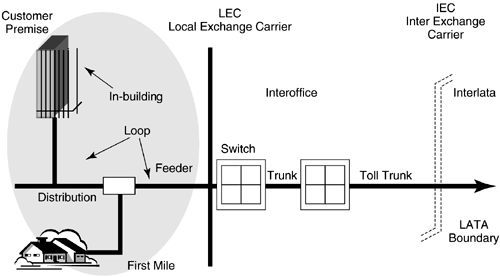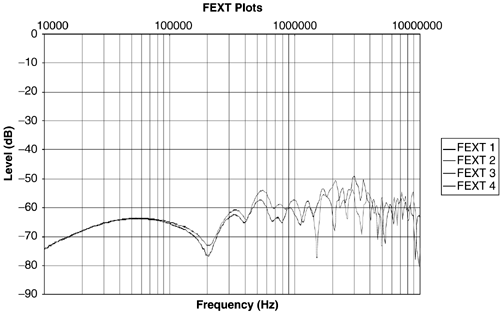7.5 Ethernet in the First Mile (EFM)
| Figure 7.27 shows the basic concept of EFM [34]. One, two or four phone lines may be coordinated to deliver 10 or 100 Mbps symmetric VDSL service in EFM. Even though "Ethernet" physical-layer copper twisted-pair standards have long been established, they are restricted to a length of 100 meters for 10 Mbps ("10BT"), 100 Mbps ("100BT") and 1000 Mbps ("1000BT"). Each uses a category-5, 5e, or 6 set of four twisted pairs in synchronous point-to-point transmission. Longer-length transmission fundamentally requires a different physical-layer modulation, while the upper layer "Ethernet/TCP/IP" functionality can be maintained so that the DSL line essentially looks like a "long-range Ethernet." The current physical-layer Ethernet use of three or four twisted-pairs in coordination admits that same possibility for EFM (clearly longer length for any given speed can be attained by sharing the transmission bandwidth of several lines to achieve the desired rate of 10 or 100 Mbps), as well as the possibility of carrying the entire data rate on just one line also (over a shorter distance than two or four coordinated lines). Figure 7.27. Ethernet in First Mile Illustration (shaded area is EFM interest). (Courtesy of H. Barass). Presently, the IEEE 802.3 standards committee is studying EFM possibilities, and VDSL proponents have suggested this is an excellent match to VDSL capabilities. However, EFM appears interested in only symmetric transmission where VDSL under Plans 997 and 998 are clearly designed for asymmetric transmission. The flexible VDSL spectra under the DMT standard in [17] clearly does allow different band use for EFM where appropriate. Some documents on EFM line modeling occur in [33],[34], but models are not fully accepted nor standardized presently for long-length lines. In particular, FEXT modeling at high frequencies becomes very important, especially with the use of multiple lines at wide coordinated bandwidths. Chapter 11 enumerates several EFM range results using dynamic spectrum management concepts. 7.5.1 Multiline FEXT ModelingThe multiple-input multiple-output (MIMO) characterization of a cable of twisted pairs merits attention and measurement for studies in Ethernet in first-mile (EFM) efforts. As noted, groups of twisted pair within a cable may be combined for better transmission/ duplexing : The interaction between lines within a subgroup or the entire cable can be exploited to improve performance and reduce transceiver complexity, motivating a model. Reference [33] suggests a temporary model for MIMO FEXT that can be used to evaluate/test EFM. MIMO FEXT ChannelFigure 7.28 illustrates the matrix or MIMO FEXT twisted-pair channel. Each of the M inputs to this matrix channel may produce a component of the signal at each of the K outputs. Usually, M = K. For instance, a quad (four twisted pairs tightly packed together) has M = 4 inputs, K = 4 outputs, and a total of 16 = M · K transfer functions of interest. These M · K transfer functions can be summarized in a K x M matrix H . The K x 1 vector of channel outputs Y is then related to the M x 1 vector of channel inputs X by Figure 7.28. Matrix channel. In some cases, four pair is really eight separate wires, allowing a 7 x 7 matrix channel. Ultimately, the designer would desire the exact H for each binder of wires: Any FEXT information is contained within this matrix. Approximate models are of interest in evaluating the various EFM opportunities in terms of range, rates, and service applications/market. In recognition that such transfer matrices are not well known, Reference [33] suggests H an model for temporary use in EFM studies. NEXT matrix models are of less MIMO interest because NEXT is either avoided by duplexing choice or by echo/NEXT cancellation between lines. The km th element of Equation * with a worst-case value of This same FEXT model is often seen in a form that describes only energy transfer, in other words the squared magnitude of Equation (*). Here, the model is converted to voltage transfer because EFM studies may desire phase information also. The equation above may sometimes be augmented by a linear phase term e j 2
However, actual individual FEXT insertion losses do not follow such a smooth characteristic with frequency and indeed vary up and down with respect to the model in Equation (*), see Figure 7.29. The variations can vary with the individual pairs as in Figure 7.29. Figure 7.29. 500-meter example FEXT insertion loss functions. (Courtesy of John Cook of BTexact). The inaccuracy of the Equation (*) model is increasingly evident at higher frequencies. There is a raised sinusoidal appearance to the magnitude transfer. This plot shows coupling functions between a pair on a 500 meter .5 mm cable with 50 pairs. Cosine terms can be added to the model to closely approximate the location of the dips and peaks in frequency seen in the measured FEXT insertion loss functions. Thus, the proposed model is where H ( f ) is as above derived from standard transmission theory. c line is the speed of light on the media (often just use 300 Mmeters/sec), and The following table suggests values for h fext and n lines :
This proposed MIMO FEXT model attempts to augment well-known existing models to include:
This model is in somewhat of a state of improvement at time of writing and likely readers would want to pursue dynamic spectrum management and EFM standards of future to get any updates occurring after time of writing. |
| Top |
EAN: 2147483647
Pages: 154







 is a phase term (i.e.,
is a phase term (i.e.,